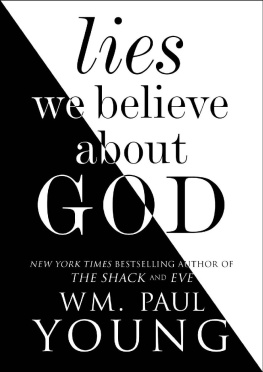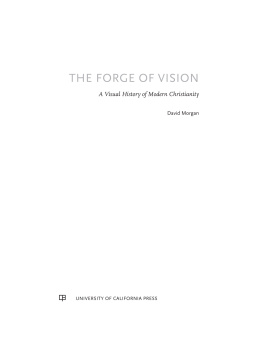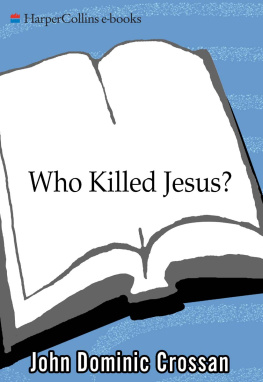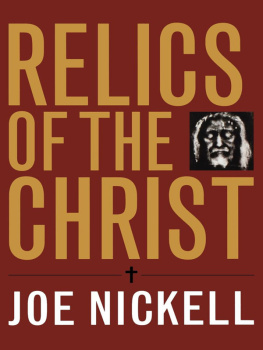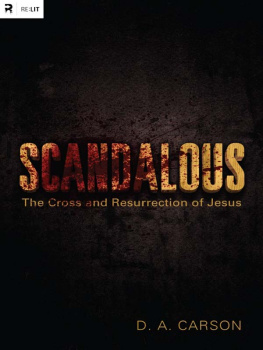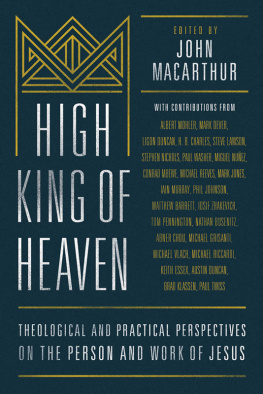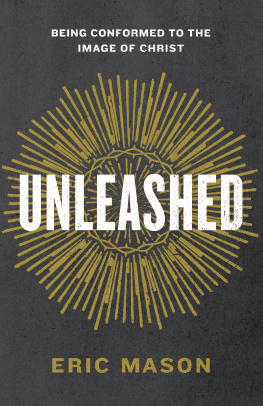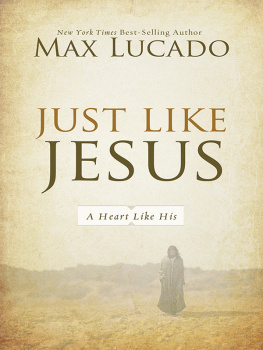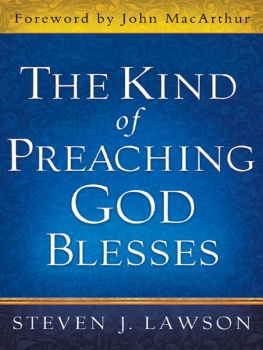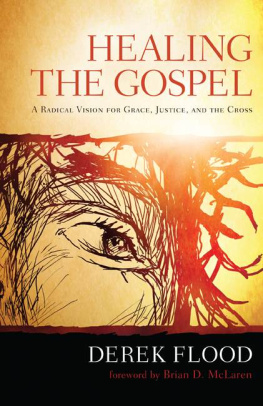Thank you for downloading this Atria Books eBook.
Join our mailing list and get updates on new releases, deals, bonus content and other great books from Atria Books and Simon & Schuster.
C LICK H ERE T O S IGN U P
or visit us online to sign up at
eBookNews.SimonandSchuster.com
Contents
To Scott Closner, my best friend.
You were the first man in my life who told me that no matter how badly I messed up, you werent leaving.
Thank you!
To Tim, my brother.
You have lived a life of questions, mostly unspoken, but questions about things that matter. You matter!
I love you!
Foreword
M ost Christians have a deep desire to be faithful to Scripture, as do most biblical scholars. Yet what constitutes faithfulness and how to achieve it is another question. Several months ago I read a book titled Four Views of Hell. Four scholars, determined to be faithful to Holy Scripture, presented four entirely different and certainly opposing views of the biblical teaching on hell. These writers believed they were presenting the true teaching of the Scriptures. I do not doubt the integrity of the four authors. But the differences in interpretation highlight the fact that something other than reading the Bible is involved. Very often the deepest question, and the one most ignored, is how to read the Bible. What does it mean to read the Bible correctly? How do we go about deciding?
Some of my friends laugh at such questions. Baxter, they exclaim, it is right there in plain English! Any honest person can understand what it says.
Yet the fact is, we all bring our family prejudices, our personal histories, and our habits of thought into our reading of the Scriptures. Just as we cannot hear our own accents, we cannot readily see our own assumptionsassumptions that shape what we see and how we see it. Not least this applies to what we see in the plain teaching of the Bible. It is important to ask ourselves questions about the way we read the Bible.
N. T. Wrights new book, The Day the Revolution Began, makes this very point. Wright carefully lays out what he believes to be the larger, biblical picture, what many call the metanarrative of the Bibles story, which then guides our interpretation of the details. His big picture leads him to seriously challenge doctrines long held as plain and obvious to us in Protestantism. Whether or not one agrees with Wright, his book puts us in a place where (like it or not) we can hear our accents, and at least notice our prejudicesprejudices that have a profound impact on what we consider obvious.
My dear friend, Paul, has ventured beyond his wonderful and challenging fiction novels and here offers a more straightforward book about what he believes Lies We Believe About God. This is a great book, but like Four Views of Hell and The Day the Revolution Began, it, too, has a very definite framework of assumptions. How does Paul determine what are lies and what is the truth? I can assure you, there will be places where some will throw up their hands and think, Has the brother lost his mind? When our understandings of the larger story of the Bible differ, then our beliefs about the details differ, too, and we see things differently.
So what is Paul Youngs baseline? What are his core beliefs? How does he see the larger story of the Bible that so shapes his outlook and determines what he thinks is the truth and, therefore, what he believes are lies that need to be challenged? If you will allow me a paragraph or two, I will take you behind the curtain and lay out these beliefs as clearly and honestly as I am able. For here, Paul and I are brothers who walk together, and what we believe informs the way we think about a wide range of biblical and human issues.
Paul and I agree that the New Testament explodes in the joyous conviction that Jesus Christ is the Lord God in Person. He laid down His life for the forgiveness of sin and to defeat the powers of death that enslaved humanity, and that as life incarnate, He rose victoriously from the dead. The gospels and letters that make up the New Testament are attempts to explore and express the meaning of Jesuss presence and death. The apostles, John and Paul in particular, realized the staggering implications of Jesuss very identity as the Son of God incarnate, crucified, resurrected, and ascended. Apostle Paul envisions Jesus as being with the Father before creation as the One in and through whom humanity is created and given the gift of grace (2 Timothy 1:9), and as the One in and through whom the Father chose us and predestined us to adoption before the foundation the world (Ephesians 1:45). The apostle Paul sees Jesus as the One in and through and by and for whom all things were created in the heavens and on the earth, the One who was before all things, and the One in whom everything is sustained and held together (Colossians 1:1617).
For me and Paul Young, such thoughts are astonishing and worthy of the most serious reflection. Paul, the apostle, thinks of Jesus as there with the Father before the creation of anything, and he sees Jesus as the center of the divine plan for the entire cosmos. Indeed, he proclaims that Jesuss incarnate life, death, resurrection, and ascension is the summing up of all things in heaven and on earth (Ephesians 1:10). These are seriously radical ideas to almost anyone in the ancient and modern world.
The great apostle John agrees with Apostle Pauls astonishing vision and thinks of Jesus as the eternal Word of God, face-to-face with the Father before creation, and as the One in whom all things were created. John is emphatic: All things came into being by Him; and apart from Him nothing came into being that has come into being (John 1:13). Think about it. For the apostles John and Paul, and I suspect the others, we will never meet anything anywhere at any time that did not originate in and through Jesus Christ and is not constantly, moment by moment, sustained by Him. It is these core beliefs about Jesus that formed the apostolic mind, informing and re-forming their vision of God, of humanity, and of creation, with the crucified and resurrected Jesus at the center of all. Jesus himself declared, I AM the light of the cosmos, the one who follows me shall never, ever walk in the darkness, but shall experience the light of life (John 8:12).
While there is enough here for us to understand Youngs basic framework, please allow me space to add a touch of history. As the news of this Jesusthe crucified and resurrected Son and Creatorspread across the Mediterranean basin and beyond, it collided with existing cultures and worldviews, ingrained prejudices, and habits of thought. The identity of Jesus Christ as the Son of God, the One anointed in the Holy Spirit, crucified and resurrected , simply made no sense to people, and the implications of His existence rocked the status quo everywhere. The news of Jesus was turning the world upside down, creating a universal, tumultuous writhing inside human thought. Explosive debates developed, even wars. Many believers were burned alive and crucified as martyrs.
Who is Jesus, really? What does His existence mean? There were many answers. How could the apostolic vision of Jesus Christ not disturb the empire, whether the empire was external and systemic (religious and political) or internal and personal? The temptation to domesticate the Jesus of the apostles was ever present and convenient. In AD 325, bishops from the global Church were summoned to Nicaea (in present-day Turkey) to make a definitive statement about Jesus. The flamboyant and popular presbyter named Arius put forward the notion that Jesus was not God, not really God, but the first and highest of all Gods creations, through whom all other things were then created. Bishop Alexander and others countered that the apostles taught that Jesus was God of God incarnate. Eventually the debate was settled as the council agreed that Jesus was of the same being as the Father ( homoousios to Patri ), thereby envisioning Jesus as the fully divine, incarnate, eternal Son of the Father and the Creator of all things in heaven and on earth, incarnate. It was this mysterythis culturally inconceivable proclamation that Jesus was of Gods very being incarnate (confirmed at both the Constantinople and the Chalcedon Councils)that was handed down as the central truth of all truths of Christian faith.

